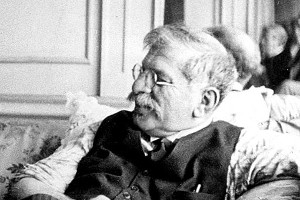



Being male
from machismo to feminism
The title may sound provocative, but serves as the teasing mirror to the notion of becoming gay, acquiring same-sex attraction, identity or recognizable features. Ironically, it may be closer to the truth in case of heterosexuals, than it was ever for the queer men.
It is not a mistake to analyze evolution of masculinity and femininity through biology. Comparing with other animals and especially with our direct ancestors. Quite a usual pattern is observing male engaging in aggressive behavior – hunting for food, chasing off the competitors, protecting his chosen mate, but especially his offsprings - direct continuation of his genetic pool. Prehistoric (and a bit cliché) men did hunt, had to escape from other predators, survive in wilderness. Their specialization was more physical (nowadays: sports, bodybuilding, action, doing) - strength, coordination, speed. The focus was on improving chances of survival – by competing but also cooperating in packs (nowadays: teams, squads, bully gangs, nations), guarding the resources in their territory (nowadays: patriotism, nationalism), or developing tools (nowadays: technical specializations, but often on behalf on minimalist communication). Killing prey, killing competitors, killing aggressors was inevitable, they did not need to develop refined emotionality or communication soft skills. On the contrary – the endurance, hardiness, assertiveness were desirable features. It all just survived longer than necessary.
For long time of history (except some cultures, e.g. Native Americans, who recognized 3-4 genders), heterosexuality did not exist. It started to appear in the middle of 19th century, alongside pathologized homosexuality. There were just men and women, with vague codes of proper conduct. That included different gender roles – bravery, honor and warring for one - cooking, submission and fragility for the other. The only tolerated sexual expression was with the opposite sex, procreative. Not that the attraction (or some notion of aesthetics) towards the same sex did not exist, sometimes it was even acknowledged, but it was either ritualized in pederasty (ancient Greece, Islamic world), or straightforward outlawed. It was not considered an identity, but one of the possible behaviors.
After the same-sex attraction was finally discussed openly, scientifically analyzed and considered at least on medical terms – homosexuality and heterosexuality appeared in language. First as discrete categories – as much men an women. All together four different combinations. Of course, for the unbiased observer, nothing in the nature appears discreet. The bisexuality complemented those in relative short time. Thanks to Alfred Kinsey’s research, although initially with dubious sociological sample, a sexuality continuum model appeared. Exclusive heterosexual and exclusive homosexual behavior were considered extremes – with some part of society falling in between.
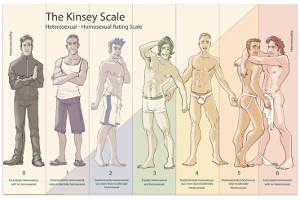
Kinsey scale (artist's interpretation)
0 (life-long straight without a single bi experiment)
6 (life-long gay with no interest in women whatsoever)
Modern take on sexuality continuum, from the straight extreme (toxic masculinity) to gay extreme
- do you hate men, you would kill them all, you can’t stand seeing them around you, you find them disgusting beings?
- you like only women, but don’t mind other men existing … you can befriend them … even if their physical presence is somewhat intimidating
- you are sexually attracted to women, but you feel no stress around other male bodies – in the queues, crowds, showers, saunas)
- you can accept touching male bodies in ritual context (shaking hands, patting shoulders, hugging friends, celebrating victory, teasing, comforting in extreme situations), perhaps under condition of careful enactment, emphasizing detachment, reconfirming your own toughness, supporting it with artificial language (deep voice, joking)
- other male bodies do not bother you at all, you can even observe and admire them in their exaggerated physical perfection – bodybuilders, Olympic athletes, football players (which most straight men constantly do). While still perceiving them in asymmetrical dichotomy: male: strong, female: beautiful (implicating the opposites as well)
- a concept of male beauty does not feel alien to you, you can point out a "handsome" man, distinguish the differences in attractiveness of various men
- you don’t mind being seen and evaluated in terms of beauty – by other women, or even by some of the men. You are comfortable with their looks and gestures of admiration, if they do not cross your intimate zone without consent.
- you recognize erotic dimension in non-sexual same-sex contact – for example wrestling – though not necessarily attracted to act on it
- you distinguish between acted disgust over male body (teasing games with peers) – a compulsory expression while being seen – and calm indifference towards non-attractive sex, when considering it on your own, privately
- you don’t feel disgust when you watch a sexual scene where another man appears – kissing woman, touching her, getting nude, copulating with her, displaying his aroused genitals
- you don’t mind or even enjoy intimacy with other men who are close to you as friends, comforting, hugging, sleeping together
- kissing other men feels okay, even pleasant, without needing to go any further
- giving hand-jobs within friends circle (only your clearly-straight mates? any well-built men?) does not present an attack on your identity
- you regularly self-suck
- you don’t feel a problem with giving or receiving oral sex to another man, enjoying his genitals as much as your own.
- you had intimate or sexual contact with other men – once, when you were in exploring phase, out of curiosity – rarely – regularly
- you had even anal sex with man, enjoyed it, but preferring to play with women
- you enjoy some parts or characteristics of male body (genitals, butt, muscles), but not the body as a whole, or its smell, or hairy and rough texture
- you can have sex with a man, but in a sport-like context, no kissing, no intimacy, no attachments, no emotions, no drama
- you like male body equally in all its expressions - if it is attractive - you don’t care about the sex of your partner
So far we got only close to the mid-point, the bisexuality, the other half of the spectrum unfolds in reverse questioning.
Of course, the stigma of difference, abnormality or even sin causes that many who had those experience away from the straight edge, do not admit them. Some talk about them, but with anxious emphasis on their still-heterosexual identity. Those who would voluntarily participate in such study are usually more relaxed about even thinking of these various possibilities and accepting the intermediate identities. For many men, used to life in precisely-designed straight caricature, never being challenged to reflect upon the other possibilities, thinking of "would you" even on their own, in the intimacy of their own mind, does not feel comfortable – their answer is premature "no". Therefore it appears quite difficult to conduct Kinsey-esque research, on a representative sample, presenting decisive results.
Not so consciously, even straight men engage in same-sex contact, quite regularly. With themselves. While masturbating, they touch male body, male genitals, get first hand experience of the pleasure that masculine body can feel. Unlimited by competitive performance (talking about sex, showing off) around other men, but also constrained soft-acting around women (who demand gentleness, emotions, care). On their own, they can be mechanical, practical, unromantic – as it suits their nature or nurture. Beyond straightness, not so few men scrutinize and flex their muscular bodies in front of the mirrors – goddess knows what "perfect man" they try to see there. According to a recent study almost 40% of straight men discover pleasure of anal sex, their G-spot placed ironically in the the no-go zone. They have to overcome centuries-old jokes about penetration, the definition of gayness.
A brief random selection of the articles describing the experience of straight men with receptive anal sex: [1] [2] [3] [4] [5] [6]
The history and anthropology presents a multitude of examples, where particularly romantic, intimate or even sexual contact among men (or women, even if their perspectives are quite ignored by the early singularly-male historians) happened, was habitual or even became a norm. Just a notion of sin in ancient literature and the complex penal system – reveals the ever-presence of same-sex intercourse. Physically or culturally segregated societies are prone to or even develop same-sex closeness. In ancient times older mentors passed the knowledge to the young ones both in the intellectual, artistic and physical dimension – the concept known as pederasty. This rite survived in middle-eastern cultures - who otherwise persecute extra-marital sex or even mere contact between men and women - so the same-sex contact become an outlet, in wide range from holding hands, through romanticism, deep emotional friendships to providing sexual release.
Pre-modern western men lived in highly gender-distinct society, naturally developing warm mutual connections among themselves. Women were subordinate - their will, opinions or even sexual pleasure was non-existent - they provided sexual and household services. Men sought intimacy, understanding and sharing with their mates. Compulsory military conscription during war times, in combination with extreme situations, engagement in carnage and high probability of death compelled men to enjoy the possibly last moments of their lives fully within the circumstances, with less inhibitions and shame, resorting to mutual intimate bonding.
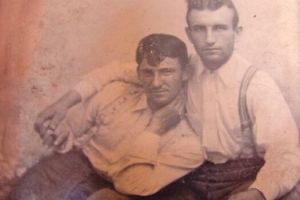
Gender stereotypes of what is manly used to be different
(Credits): Gallery Miss Magnolia Thunderpussy Ipernity
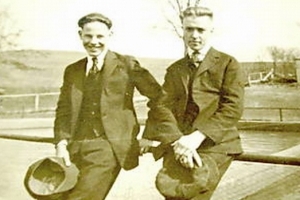
Men conquered and ruled - while wives awaited at home
(Credits): Gallery Miss Magnolia Thunderpussy Ipernity

The "gentle" in gentleman was not an oxymoron yet
(Credits): Gallery Miss Magnolia Thunderpussy Ipernity
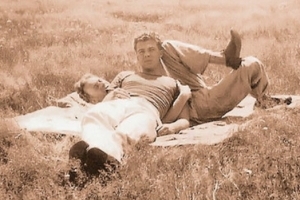
The men and women used to live in separate spaces
(Credits): Gallery Miss Magnolia Thunderpussy Ipernity
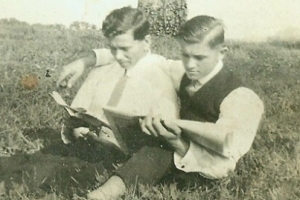
woman was an object, a trophy to win, an asset to show
the intercourse was an of dominance, to procreate
(Credits): Gallery Miss Magnolia Thunderpussy Ipernity
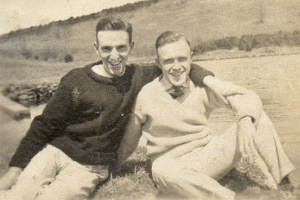
intimacy, trust and kindness had to be found elsewhere.
(Credits): Gallery Miss Magnolia Thunderpussy Ipernity

No homos, no heteros, just men - unashamed in intimacy
(Credits): Gallery Miss Magnolia Thunderpussy Ipernity
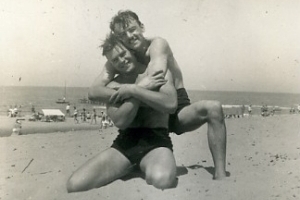
Physical affection was considered natural, not sexual,
(Credits): Gallery Miss Magnolia Thunderpussy Ipernity
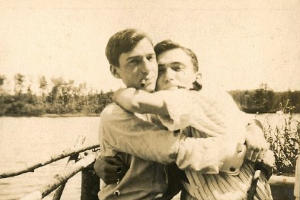
Man could say "I love you" without inappropriate implications
(Credits): Gallery Miss Magnolia Thunderpussy Ipernity
After the normative 1950s, the flower, hippie and sexual revolutions of 1960s decompossed the ancient norms, love and softness have become a custom. Approximately a decade later, the gloomy Thatcherism and Reaganism 1980s (+moral majority, HIV) replaced this with somewhat rough culture – in appearance and attitudes: hate, mean jokes and friendly punches have become the rituals of association. The omnipresent action-hero and martial-arts fashion (Bruce Lee, Schwarzenegger, Stallone, Van Damme, Seagal, Norris, Lundgren) normalized hazing, humiliation, combative humor, humiliating remarks, getting on top of the other as a new form of communication. The detachment and aggressive attitude have become distinct features of masculinity. Some cultures accepted this point of history as a cargo cult and still struggle to overcome it.
Feminism seems to evolve in segregation from the mainstream culture clinging to its bi-polar dynamics and ideals of masculinity. It exists in clubs and labs of intellectuals. The machismo perceives feminism as its nemesis, suspecting its intentions to overthrow the reign of men and replace it with women in charge. Incapable of taking perspective, that "overthrowing" and "winning" and "ruling" are themselves machismo concepts. The idea of power balance, sharing, no one being on top, every sex, gender and orientation just being, being themselves, exploring what themselves means, finding the best in their potential – does not compute in male mind, whether it is wired so biologically or a cultural footprint.
Instead of plotting how to depose alphas from their throne and replace them with the queen, feminists scrutinize the sources and concepts of masculinity. One of the inspiring works by Elisabeth Badinter notes, that masculinity evolves in competitive/combative opposition to anything feminine. There is no notion of being "comfortably male". Men are not weak, men do not cry, men do not show emotions, men do not fall back, men do not run away, men do not talk too much, men are not girls, men are not gay, men do not wear this and that, men do not talk this and that way, men do not do this and that. "A man is not ..." - seems to be a definition of a man. At the end, it looks like a man is not. It does not exist. It is invented. It is acted. It is proven in front of other men. It is an ideal to pursue. It is an super-human effort.
Is there a positive definition of masculinity? Isn’t it a reason for envy towards women – that they are just born female, they are female, without having to do, act, acquire, or get their femininity approved? No, as much as men seek, enjoy and fetishize discomfort in adventure - with all the hardship, pain, mud and blood – so they feel a vain pride in stoical detachment from feelings, desires and sometimes even physical or emotional pleasure. Proving their super-hero strength, showing off with their acrobatic skills, displaying ridiculously ancient role-play … even if no one is applauding anymore, or the praise is acted not to make them feel embarrassed.
Men often seem to be more interested in proving malehood to their competitively judgmental peers, to be accepted by the exclusive boys clubs, the hierarchy in the hunting wolfpack - than sexually, emotionally or friendly interested in women. Men are more afraid of wearing social label "gay" (loss of status among men) - than being perceived as modern or progressive or tolerant by their female partners. Much more than disgusted by imagining of "having to" have sex with a man. (If one is gay, having sex with a man is not disgusting at all, it is just pursuing what one desires, what is pleasant. If one is straight, he has no reason to imagine sexual interaction with the same sex.)
Walk like a man, talk like a man. Constant acting. No wonder that gay-men are so obsessed with straight-acting, copying not just masculine traits, but even the concept of acting straight as such, from their alpha-male role-models. Queer men have a gift of perspective – not that they harvest it at every opportunity. Distancing themselves from the peer pressure – archetypal coming out process is in fact an exercise of resisting the judgment of norms – they try to reinvent more comfortable identity, freely adapting masculinity and femininity. However, aside of the politics, there are rules of attractions, that provide a sarcastic reality-check to well-meant ideology. Gay men fall for the straight men, value masculine appearance, detest asexual effeminacy – of course in the others – even if hapless in their definitions quite like their straight mates. It is hard to distinguish relics of the masculinist cult(ure) and the animal fundamentals of the attraction. We seem to prove some truth in the polarity of attraction, despite trying to deconstruct the ancient concepts of genders.
Thanks to the scientists who have taken perspective on their cultural bias, particularly anthropologists coming from the puritan christian backgrounds – researching Native American societies, we have been able to overcome simplistic man-woman model, first developing the notion of sex and sexual orientation, later uncovering even further categories: outer sexual characteristics (what body and organs one is born with), gender (what sex we are attributed by the family and society), gender roles (how are we expected to act in our attributed sex), gender stereotypes (what our culture prohibits and commands us to wear or do within our gender roles), sexual identity (what sex or gender we feel and are deep inside), sexual orientation (what sex we are attracted to). The last one often gets complicated by the blurry distinction between bodies and roles and identities. We are raised and live drugged by our culture’s conceptualization, clumsiness and limitations of the language, archetypal stories and communication exchange that shape our thinking patterns.
Speaking of gender roles: at one time pink was popular male color, a few centuries later it was unacceptable. In some cultures men dress in black suits, while women monopolize beauty and charm through colorful, glittery and erotic display of their bodies, in others women are veiled in shape-masking hijab, while men appear somewhat more flamboyant. Some places crossing legs in knees belongs to feminine gestures, men cross in ankles – elsewhere they don’t make much fuss. Vikings and American natives kept their hair long, Europeans cut them practically short. Gentlemen shaved their beards, orthodox Muslims are warned from doing so. Englishmen wore pants, Scots felt masculine in their kilts. Circumcision is American, Jewish and Muslim men’s rite of passage into masculinity, for European and Asian men it appears rather ridiculous and damaging.
For some, these new identity categories provided a living space, a salvation. Transsexuals, transgenders, intersex, gender queers, asexuals – found their name, self-acceptance, peers and perhaps even partial understanding. Contemporary world copes with the inflation of identities, sometimes slow and sometimes too fast and perhaps too forced reinvention of language with preferred pronouns, but also backlash from those who don’t like anything to be imposed on them. For some a breakthrough, for some a pseudo-science of intersectionality – similarities and synergy of phobias – sometimes seen as the "Oppression Olympics". What once used to be a fringe community – gay men and lesbian women – diverge in gender queer and assimilationist currents. Some rediscover their true self in reinventing their identity, finding relief in non-acting, comfort in non-masculine self-expression. The other experience a paradox – the genuine deep attraction towards hard-to-define but still easy-to-recognize masculinity.
